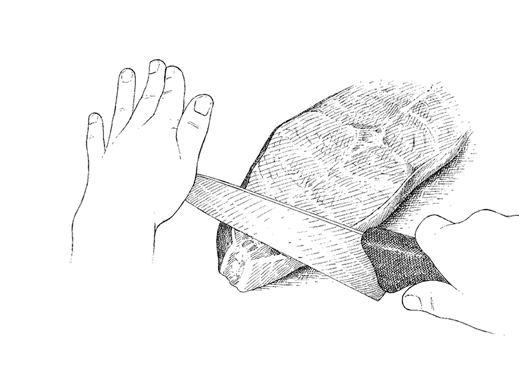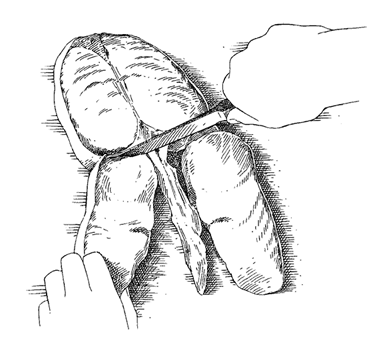The Cook's Illustrated Cookbook (209 page)
Read The Cook's Illustrated Cookbook Online
Authors: The Editors at America's Test Kitchen
Tags: #Cooking

MAKES
1¹⁄
2
CUPS
Scallions can be substituted for the shallots.
6 | ounces cherry or grape tomatoes, quartered |
¹⁄ | teaspoon salt |
¹⁄ | teaspoon pepper |
6 | tablespoons extra-virgin olive oil |
3 | tablespoons lemon juice |
2 | shallots, minced |
2 | tablespoons minced fresh basil |
Combine tomatoes with salt and pepper in medium bowl and let stand until juicy and seasoned, about 10 minutes. Whisk oil, lemon juice, shallots, and basil in small bowl; add to tomatoes and toss to combine.

Cutting off the cartilage at the ends of the steaks ensures that they will fit neatly in the pan and diminishes the likelihood that the small bones located there will end up on your dinner plate.

Remove skin from cooked steaks and separate each quadrant of meat from bones by slipping spatula or knife gently between them.
![]() WHY THIS RECIPE WORKS
WHY THIS RECIPE WORKS
Moist and rare in the middle with a nice exterior crust, pan-seared tuna is a popular entrée in restaurants. To make this dish at home, we found starting with high-quality tuna—sushi grade if possible—was paramount. A thickness of at least 1 inch was necessary for the tuna to remain rare at the center and at the same time achieve a good sear on the exterior. Before searing the tuna in a nonstick skillet, we rubbed the steaks with oil and coated them with sesame seeds. The sesame seeds browned during cooking and formed a beautiful, nutty-tasting crust.
SERVES 4
Most members of the test kitchen staff prefer their tuna steaks rare to medium-rare; the cooking times given in the recipe are for steaks cooked to these two degrees of doneness. For tuna steaks cooked medium, observe the timing for medium-rare, then tent the steaks with aluminum foil for 5 minutes before slicing. If you prefer tuna steaks cooked so rare that they are still cold in the center, try to purchase steaks that are 1¹⁄
2
inches thick and cook them according to the timing below for rare steaks. Bear in mind, though, that the cooking times below are estimates; check for doneness by nicking the fish with a paring knife. Serve with Ginger-Soy Sauce with Scallions or Avocado-Orange Salsa (recipes follow), if desired.
³⁄ | cup sesame seeds |
4 | (8-ounce) tuna steaks, 1 inch thick |
2 | tablespoons vegetable oil |
Salt and pepper |
1.
Spread sesame seeds in shallow baking dish or pie plate. Pat tuna steaks dry with paper towels, rub steaks all over with 1 tablespoon oil, then season with salt and pepper. Press both sides of each steak in sesame seeds to coat.
2.
Heat remaining 1 tablespoon oil in 12-inch nonstick skillet over high heat until just smoking. Add tuna steaks and cook 30 seconds without moving. Reduce heat to medium-high and continue to cook until seeds are golden brown, about 1¹⁄
2
minutes. Using tongs, carefully flip tuna steaks and cook, without moving, until golden brown on second side and centers register 110 degrees (for rare), about 1¹⁄
2
minutes (steaks will be opaque at perimeters and translucent red at center when checked with tip of paring knife), or 125 degrees (for medium-rare), about 3 minutes (steaks will be opaque at perimeters and reddish pink at center). Cut into ¹⁄
4
-inch-thick slices and serve.
Omit sesame seeds and press ¹⁄
2
teaspoon cracked black or white peppercorns into each side of oiled tuna steaks.
MAKES 1 SCANT CUP
If available, serve pickled ginger and wasabi, passed separately, with the tuna and this sauce.
¹⁄ | cup soy sauce |
¹⁄ | cup rice vinegar |
¹⁄ | cup water |
2¹⁄ | teaspoons sugar |
1 | scallion, sliced thin |
2 | teaspoons grated fresh ginger |
1¹⁄ | teaspoons toasted sesame oil |
¹⁄ | teaspoon red pepper flakes |
Combine all ingredients in a small bowl, stirring to dissolve sugar.
MAKES ABOUT 1 CUP
To keep the avocado from discoloring, prepare this salsa just before you cook the main dish. See
“CUTTING ORANGES”
for information on segmenting oranges.
1 | large orange |
1 | avocado, halved, pitted, and diced medium |
2 | tablespoons minced red onion |
2 | tablespoons minced fresh cilantro |
1 | small jalapeño chile, stemmed, seeded, and minced |
4 | teaspoons lime juice |
Salt |
Peel orange, making sure to remove all pith, and cut into pieces. Combine all ingredients in small bowl and season with salt to taste.
![]() WHY THIS RECIPE WORKS
WHY THIS RECIPE WORKS
Producing crisp-crusted restaurant-style scallops means overcoming two obstacles: chemically treated scallops and weak stovetops. We wanted to achieve superior pan-seared scallops that had a perfectly brown crust and no hint of off-flavors. We decided to work with wet scallops (those that are chemically treated with STP, a solution of water and sodium tripolyphosphate, to increase shelf life and retain moisture) first. If we could develop a good recipe for finicky wet scallops, it would surely work with premium dry (untreated) scallops. We found that waiting to add the scallops to the skillet until the oil was beginning to smoke, cooking the scallops in two batches instead of one, and switching to a nonstick skillet were all steps in the right direction. But it wasn’t until we tried a common restaurant technique—butter basting—that our scallops really improved. We seared the scallops in oil on one side and added butter to the skillet after flipping them. (Butter contains milk proteins and sugars that brown rapidly when heated.) We then used a large spoon to ladle the foaming butter over the scallops. Waiting to add the butter ensured that it had just enough time to work its browning magic on the scallops, but not enough time to burn. Next we addressed the lingering flavor of STP. Unable to rinse it away, we decided to mask it by soaking the scallops in a saltwater brine containing lemon juice. For dry scallops, we simply skipped the soaking step and proceeded with the recipe.
BUYING SCALLOPS
When buying sea scallops, look first at their color. Scallops are naturally ivory or pinkish tan; processing (dipping them into a phosphate and water mixture to extend shelf life) turns them bright white. Processed scallops are slippery and swollen and are usually sitting in a milky white liquid at the store. You should look for unprocessed scallops (also called dry scallops), which are sticky and flabby; they will taste fresher than processed scallops and will develop a nice crust when browned because they are not pumped full of water.
SERVES 4
We strongly recommend purchasing “dry” scallops (those without chemical additives). Dry scallops will look ivory or pinkish and feel tacky; wet scallops look bright white and feel slippery. If using wet scallops, soak them in a solution of 1 quart cold water, ¹⁄
4
cup lemon juice, and 2 tablespoons salt for 30 minutes before proceeding with step 1, and do not season with salt in step 2. To remove the tendons from the scallops, simply peel away the small, rough textured crescent-shaped tendon and discard.
1¹⁄ | pounds large sea scallops, tendons removed |
Salt and pepper | |
2 | tablespoons vegetable oil |
2 | tablespoons unsalted butter |
Lemon wedges or sauce (recipes follow) |
1.
Place scallops on rimmed baking sheet lined with clean kitchen towel. Place second clean kitchen towel on top of scallops and press gently on towel to blot liquid. Let scallops sit at room temperature 10 minutes while towels absorb moisture.
2.
Sprinkle scallops on both sides with salt and pepper. Heat 1 tablespoon oil in 12-inch nonstick skillet over high heat until just smoking. Add half of scallops in single layer, flat side down, and cook, without moving, until well browned, 1¹⁄
2
to 2 minutes.
3.
Add 1 tablespoon butter to skillet. Using tongs, flip scallops and continue to cook, using large spoon to baste scallops with melted butter (tilt skillet so butter runs to one side) until sides of scallops are firm and centers are opaque, 30 to 90 seconds longer (remove smaller scallops as they finish cooking). Transfer scallops to large plate and tent loosely with aluminum foil. Wipe out skillet with wad of paper towels and repeat cooking with remaining oil, scallops, and butter. Serve immediately with lemon wedges or sauce.
